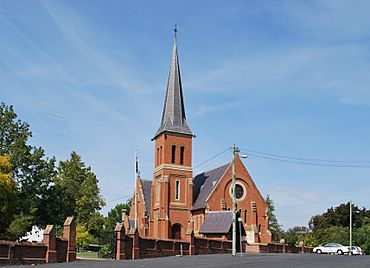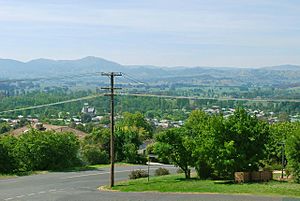Tumut facts for kids
Quick facts for kids TumutNew South Wales |
|||||||||||||||
|---|---|---|---|---|---|---|---|---|---|---|---|---|---|---|---|

All Saints Anglican Church, Tumut
|
|||||||||||||||
| Population | 6,631 (2021 census) | ||||||||||||||
| Postcode(s) | 2720 | ||||||||||||||
| Elevation | 305.0 m (1,001 ft) | ||||||||||||||
| Location | |||||||||||||||
| LGA(s) | Snowy Valleys Council | ||||||||||||||
| County | Wynyard | ||||||||||||||
| State electorate(s) | Wagga Wagga | ||||||||||||||
| Federal Division(s) | Eden-Monaro | ||||||||||||||
|
|||||||||||||||
|
|||||||||||||||
Tumut is a lovely town in the Riverina region of New South Wales, Australia. It sits right by the Tumut River.
This town is located at the foot of the Snowy Mountains. It is on the traditional lands of the Wiradjuri, Wolgalu, and Ngunnawal Aboriginal peoples.
Tumut is often called the 'gateway to the snowy' because it's close to the Snowy Mountains Scheme. It's about 410 kilometers (255 miles) southwest of Sydney and 525 kilometers (326 miles) northeast of Melbourne.
You can find many old and interesting buildings in Tumut. These include an Anglican church designed by Edmund Blacket and a Courthouse by James Barnet. Many local pubs have been open since the mid-1800s!
Early settlers planted many European trees here. In autumn, trees like Poplars, Elms, and Willows create a beautiful display of colors. Tumut celebrates this with a yearly event called the Festival of the Falling Leaf.
Contents
What Does Tumut Mean?
The name Tumut comes from an Aboriginal word for the area. It might be doo-maaht or doormat. This means "a quiet resting place by the river."
A Look at Tumut's History
The rivers in this area were important for the three traditional owners of the land. In summer, the high country was a meeting place for different tribes. They would gather to eat Bogong moths, which were a plentiful food source.
British farmers started to settle here in the 1830s. In 1845, a local court was set up in Tumut. The first judge was Frederick Walker.
The Tumut Post Office opened on January 1, 1849. A public hospital started in 1900. After many years of requests from the community, a railway line was built from Gundagai. It reached Tumut in 1903, with the first train arriving on December 2.
The train line was later extended to Batlow and Kunama. Train services slowly stopped in the early 1980s. The last trains ran in January 1984. The line was damaged by floods, and it was too expensive to fix.
Tumut as a Capital City?
In 1908, Tumut was one of ten places considered to be the new capital city of Australia. Other places included Albury and Canberra.
The new capital would not have been the current town of Tumut. Instead, two spots near Tumut were suggested. One was east of Tumut, in the valley of the Goobarragandra River. The other was between Tumut and Adelong. Tumut itself would have become part of this new capital area.
Before this, in 1902, the Australian House of Representatives voted for Tumut as the capital. But the Australian Senate wanted Bombala. So, they couldn't agree. In 1908, when they voted again, Tumut was removed from the list after five rounds of voting.
The town's rugby league team played in the Riverina Maher Cup competition. They started playing rugby union in 1920, then switched to rugby league in 1921.
Tumut's Weather
Tumut gets more rain than other towns in the South West Slopes. This is because it's right at the bottom of the Brindabella Range. Summers are warm to hot and dry, but nights can be chilly. Winters are cool and wet.
Sometimes, it even snows in winter! The last big snowfall was in August 2019, when snow covered the ground. Cold rain often falls when the temperature is below 5°C (41°F) in winter. Tumut usually has sunny weather, with over 113 clear days each year.
Local Businesses and Jobs
Tumut is a big center for the softwood timber industry. This industry uses trees like Pinus radiata from local plantations. CarterHoltHarvey Woodproducts has a large sawmill here. They also have a factory that makes chipboard panels.
The Visy pulp and paper mill is also near Tumut. This mill is special because it's the only Visy mill that makes paper from wood. Their other mills use recycled paper. It's one of the biggest wood mills in Australia!
Getting Around Tumut
Tumut is on the Snowy Mountains Highway. You can also use smaller roads to get to Gundagai or Canberra. The roads to Canberra go through the Brindabella Range and Wee Jasper. These routes are more direct but can be tricky due to the mountains and road conditions.
The town used to have a railway line and station from Cootamundra. It ran from 1903 until 1984, when floods stopped the service. Even though the line isn't officially closed, it's unlikely to open again.
NSW TrainLink coach services run three times a week to Tumbarumba. These coaches connect with train services to Melbourne and Sydney at Cootamundra.
Tumut also has a small airport called Tumut Airport. It's for small planes, and there are no regular flights there right now.
Sports in Tumut
The Tumut Blues are the local rugby league team. They play in the Group 9 Rugby League competition. They have won championships in 1949, 1973, 2003, 2007, 2008, 2010, and 2019.
Famous People from Tumut
- Ray Beavan – a rugby league player
- Allan Butler – a paralympic athlete
- Kim Carr (born 1955) – an Australian politician
- Reg Downing – a former Attorney General of New South Wales
- Cate Fowler AM – a theatre producer
- David Johnson – former CEO of Campbell Soup Company
- Tom Kirk – a rugby league player
- Tony McRae – a former politician in Western Australia
- Tony Quirk – a rugby league player
- John Ryan – received the Victoria Cross medal
- Sally Shipard – a former international soccer player
- Rosie Waterland – an author




